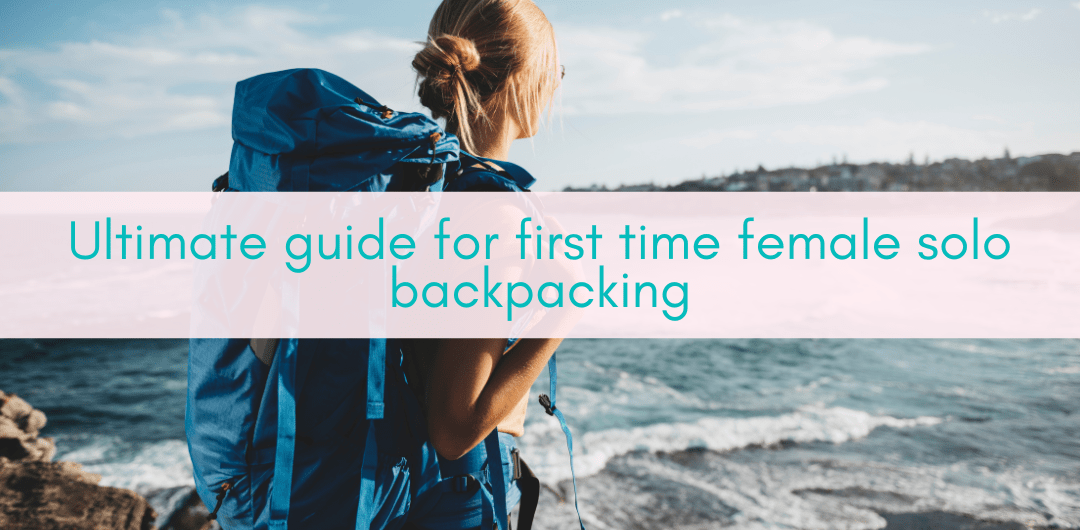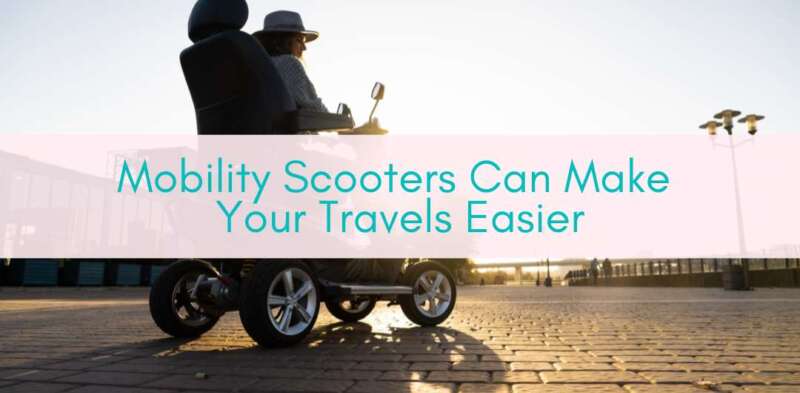You’re going to set out on your first solo backpacking trip – that’s amazing, congratulations! Whether it’s backpacking through the El Camino or the Pacific Crest Trail or somewhere else – you’re about to have an amazing experience.
However, at the same time, it’s important to be prepared and aware of the potential challenges. From choosing the right gear to mapping out your route, there’s so much to keep in mind and it can feel super intimidating. But, as with all travel adventures, if you put in the work and keep an open mind you can embark on an unforgettable journey that will leave you with memories to last a lifetime. That’s where Girls Who Travel comes in…
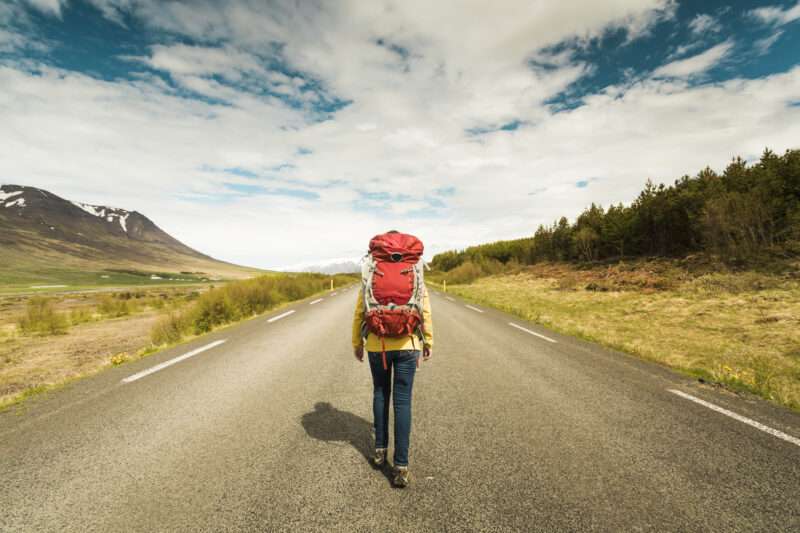
Planning Your First Solo Backpacking Trip
If you are a first-time solo traveler, planning your first solo trip can be both exciting and daunting. However, with the right preparation and mindset, it can be an unforgettable experience that pushes you out of your comfort zone and teaches you about yourself and the world around you.
Solo Female Backpacking Essentials
Packing the Essentials
The correct basics are critical to ensure a secure and comfortable trip. Here are a few must-haves:
- First aid kit: Always carry a first aid kit with you, no matter what. It ought to have things like band-aids, sterile wipes, pain relievers, and any medications you need. We’ve got First Aid Kit tips over here.
- Sleeping bag: A great quality sleeping bag is key for a comfortable night’s rest. Select one that’s lightweight and easy to pack. We cover sleeping bag tips here.
- Backpack: Select a rucksack that fits you well and has sufficient space to carry all your basics. You’ll want one with cushioned straps and a midsection belt to disperse the weight equitably. We’ve got a great backpack recommendation here.
Choosing the Right Gear
Wow, choosing gear can be overwhelming! One of the most important parts of planning your first solo backpacking trip is choosing the proper gear. You’ve got to pack light, but moreover make sure, beyond any doubt, that you’ve got all the fundamentals for your trip. Here are a few best tips to assist you in selecting the proper gear:
- Invest in a good-quality backpack that fits you well and has sufficient space for all your equipment.
- Pack flexible clothing that’s comfortable and simple to layer.
- Select lightweight and compact equipment.
- Bring a first-aid pack, an outline, and a compass.
Choosing Accommodations Wisely
When it comes to choosing lodging, security has to be your top priority. Here are a few tips:
- Research: Before you make any reservations you need to do your research. Search for reviews from other solo female travelers to learn about the security and security of the area that you are going to.
- Hostels: These aren’t just for budget travelers. Hostels are a great choice for everyone – not only because you save money but you can make friends (which can help keep you safe!). Search for ones that have female-only dorms or private rooms.
- Camping: If you decide to camp while you are traveling, choose an assigned campsite that’s well-lit and has security.
Remember, always trust your gut! As women, we’re taught to feel awkward about asking for help or setting boundaries but your safety is far more important than “manners.”
Safety Tips and Risk Management
Navigational Tools and Techniques
Getting lost is one of the biggest fears all hikers have. But with the right navigational equipment and the right plans, you’ll be able to avoid this worst-case scenario. Never go anywhere without a map and compass, and make sure you know the area that you are hiking in before you set out. Consider investing in a GPS device or downloading a navigation app on your phone as a reinforcement.
Emergency Situations Preparedness
Even after a lot of planning, crises can still happen. That’s why you should pack an emergency preparedness kit and know how to use it, and continuously carry a completely charged phone or other communication gadget in case of a crisis.
Ensure that somebody knows your plan and anticipated return time, and consider carrying an individual locator signal for added peace of mind.
Keep in mind, that the number one security tip for female hikers is to utilize common sense. Trust your instinct, maintain a strategic distance from unsafe situations, and continuously prioritize your security.
Dealing with Wildlife
Experiencing wildlife in nature can be an incredible experience, but an important thing to keep in mind is that these creatures can also be extremely dangerous. So always do your research in advance to learn what wildlife you might encounter on your hike. And no matter what, remember that you must enjoy wildlife from a distance.
When hiking, carrying bear security spray is a must. It’s not just for bears! Make absolutely sure to keep it with you at all times and know how to use it.
Understanding Local Culture and Etiquette
Even hiking, culture and etiquette matter and it’s important to know about where you’re going, to respect the land you are on and also to help keep you safe. Here are a few things to keep in mind:
- Inquire about the traditions, conventions, and taboos of the places you will be going by.
- Learn a few basic expressions of the local language.
- Dress appropriately and humbly, especially in conservative areas.
- Be conscious of nearby customs and conventions, such as expelling your shoes sometime recently entering a sanctuary or mosque.
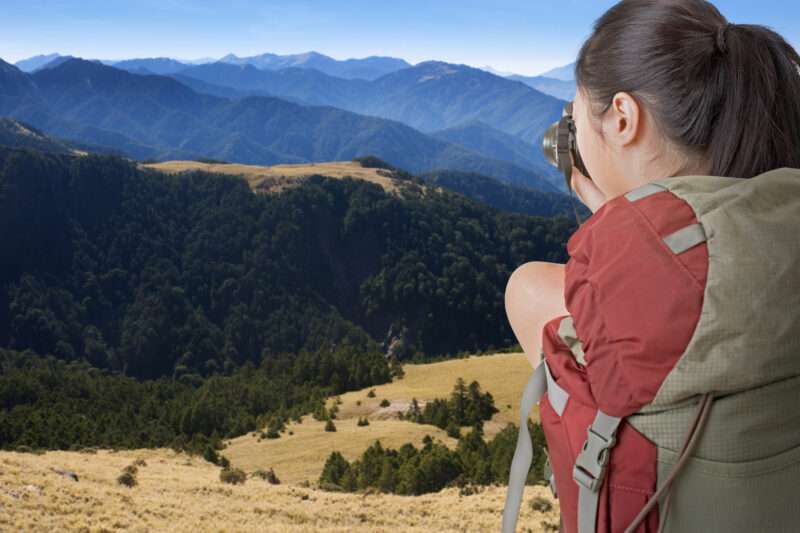
Utilizing Technology for a Safe Journey
Thanks to technology, we have some great ways of staying safe. Here are a few ways you’ll be able to utilize technology to ensure a secure and enjoyable trip.
Staying Connected with Loved Ones
One of the easiest ways to remain secure while backpacking solo is to remain in contact with your loved ones. Make sure to let somebody know where you’re going and check in with them regularly.
You should also make sure to use a tracking device like Garmin which allows you to send and receive messages and track your location even in areas without using your phone.
Leveraging Apps and Online Resources
There are a few apps and online resources that can help you stay safe while backpacking solo. Here are a few worth considering:
Google Maps: Use Google Maps to plan your course and get bearings, even when you don’t have phone service.
AllTrails: This app provides detailed path maps, surveys, and photographs to assist you arrange your climb.
Trailhead: Trailhead is a community of outdoor enthusiasts who share their encounters and tips on hiking, camping, and a kind of backpack.
RedZone: This app gives real-time rapidly spreading fire data and alerts to biggest offer assistance you avoid perilous regions.
Sitata: Sitata gives travel health and security information, including alarms about disease outbreaks and political distress.
By using these apps and online resources, you’ll better prepare yourself for your travel and stay safe while backpacking solo.
Solo Travel and Social Dynamics
Meeting New People and Making Friends
As a solo female traveler, meeting new individuals and making new friends can be one of the greatest parts of hiking. But at the same time, it can be one of the hardest parts. But don’t let that stop you. There are lots of ways to connect with like-minded people along the way.
As mentioned above, hostels are a good place to start. They regularly have common areas where travelers can hang out and socialize. Join a hostel-organized event or…just strike up a conversation with someone within the kitchen. You never know who you might meet.
Another option is to take part in a group tour. Whether it’s a hiking trip or a cooking class, doing group activities is one of the best ways to connect with people who are passionate about the same thing as you.
Finally, don’t forget social media! Girls Who Travel has 87,000+ travelers waiting to connect with you. Get advice or find a travel buddy!
You’ve got this! Overcoming the Mental Challenges.
Going out on your own can be intimidating – if it’s holding you back, know that you’re not alone. In Girls Who Travel we hear about women who are scared to head out on their own a lot. But feelings aren’t facts so start by acknowledging your fears and do not let them control you. Instead, focus on all the good things you want to get out of your journey and the sense of achievement you’ll feel when you reach your goal.
One trick for overcoming the mental side of backpacking is to break the trip down into smaller, more reasonable segments, so you do not feel overwhelmed by the enormity of the whole thing.
Hiking at Your Own Pace
When hiking solo, it’s essential to go at your claim pace. Don’t feel pressured to keep up with other hikers or push yourself beyond your limits. This is your trip, it’s not a race, and you should get the chance to enjoy it and whatever pace works for you.
Take breaks whenever you need to and never be embarrassed to ask for help if you need it. It’s also a good idea to arrange your trip and estimate your progress, so you have got a good plan of how far you would like to hike each day.
Keep in mind that hiking at your own pace doesn’t mean that you shouldn’t try and challenge yourself. Push yourself! But still honor your body and make time to enjoy the journey and appreciate the magnificence around you.
Dealing with Unwanted Attention
Tragically, as we all know, being a woman traveler – even hiking – means you can receive unwanted attention.
First and foremost, (do we sound like a broken record?) trust your instincts. If someone’s behavior makes you feel awkward, do not be afraid to walk away or seek help. Their hurt feelings are not as important as your safety.
Next, be confident in yourself. Do not be afraid to speak up and set boundaries. If someone is making you uncomfortable, tell them to stop. If they don’t do what you ask, then immediately seek help from someone nearby.
And of course, consider taking some self-defense courses before you head out on your trip. Knowing how to defend yourself can not only help keep you safe but can help you learn how to trust your instincts and trust yourself.
Girls Who Travel has the #1 Safety Course for Women which covers, among other things, self-defense techniques.
Transportation and Logistic
Planning Your Route and Itinerary
Before you leave, you must plan your route. so you can stay organized and on track, and help you avoid any potential transportation issues.
Begin by researching your destination and identifying what are the most important stops along the way. Then, determine the best way to reach each area. Will you be walking the whole way? Will you need a car or a bus at some point? If you’re driving, map out your course and make sure to have a backup plan in case of any unexpected circumstances.
When you’re hiking, it’s a good idea to have a general idea of where you’ll be staying each night. You don’t want to get stuck in the middle of nowhere without a place to sleep (even if you’re camping, you should still know where you’re planning to camp). This will help you plan your route and ensure that you have a place to sleep each night. Consider booking accommodations in advance, especially if you’re traveling during peak season.
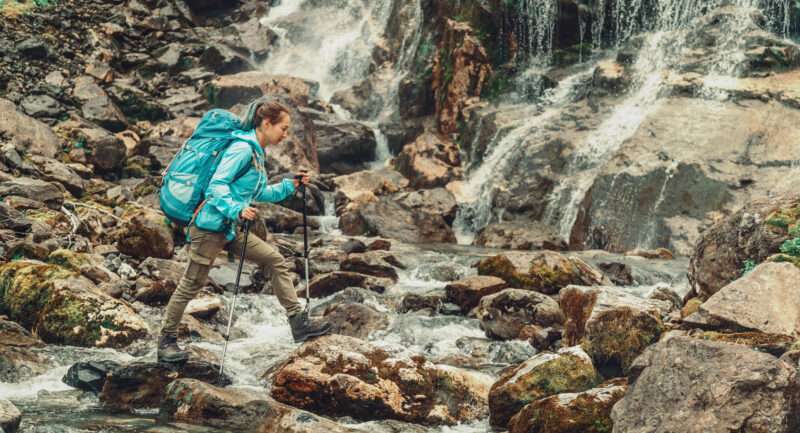
Exploring the Great Outdoors
As a solo female backpacker, exploring the great outdoors can be an incredibly rewarding experience. However, it’s important to take the necessary precautions to ensure your safety and enjoyment. Here are some tips for selecting trails and destinations, as well as experiencing national parks and wilderness areas.
Selecting Trails and Destinations
When selecting a new trail or destination, consider your skill level and physical abilities. Long trails like the Pacific Crest Trail or Colorado Trail require a significant amount of time and preparation, so make sure you have the necessary gear and experience. If you’re new to backpacking, consider starting with shorter trails and gradually working your way up to longer ones.
It’s also important to research the area you plan to visit. Look for good places to camp and reliable water sources. Check weather forecasts and trail conditions before you go. And don’t forget to obtain any necessary permits or reservations.
Experiencing National Parks and Wilderness
National parks and wilderness areas offer some of the most stunning scenery and wildlife in the world. To fully experience these areas, consider hiking to an alpine lake or summiting a peak. But remember to always practice Leave No Trace principles and respect wildlife and their habitats.
When visiting national parks, be aware of park regulations and follow them. Many parks have designated campsites and trails, so make sure to obtain any necessary permits or reservations. And always carry bear spray and know how to use it in case of an encounter with a grizzly bear or other wildlife.
Cultural Awareness and Respect
Responsible Travel Practices
As a solo female backpacker, it is important to practice responsible travel. This means being mindful of your impact on the environment and the local communities you visit.
One way to practice responsible travel is to support local businesses. By eating at local restaurants and shopping at local markets, you are supporting the local economy and helping to preserve the local culture.
Another way to practice responsible travel is to minimize your waste. Bring a reusable water bottle and refill it instead of buying single-use plastic bottles. Avoid using disposable items whenever possible and properly dispose of your trash.
Finally, be respectful of the local environment. Avoid littering and damaging natural habitats. Stick to designated hiking trails and avoid disturbing wildlife.
By practicing cultural awareness and responsible travel, you can have a positive impact on the places you visit and help to preserve them for future generations.
Reflections and Continuing the Journey
After completing your solo backpacking trip, it’s important to take some time to reflect on your experiences and plan for your next adventure. Here are some tips to help you document your adventures and plan for your next successful trip.
Documenting Your Adventures
Writing in a journal: Jotting down your thoughts and feelings each day can help you process your experiences and reflect on what you’ve learned.
- Taking photos: Capturing the beauty of the places you visit can help you relive your trip and share your experiences with others.
- Making a scrapbook: Collecting mementos, such as ticket stubs and postcards, can help you create a visual record of your trip.
Whatever method you choose, taking the time to document your adventures can help you remember the details of your trip and share your experiences with others.
This is just the beginning! We have so many resources here on Girls Who Travel to support you as you prepare for your journey. For instance, do you know about Urban Backpacking?
Founder of Girls Who Travel. Penchant for travel, yoga, writing, marketing, high heels and words like penchant.


